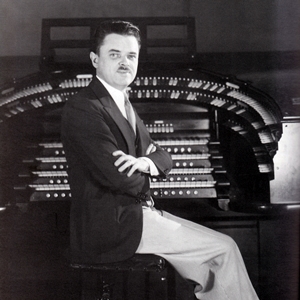Theatre Organ History - Early Organists
Theatre Organ History - Early Organists
Theatre organs would never have become popular without popular musicians to play them. In some ways, the man or woman who rose from the depths of the orchestra pit astride one of these massive organ consoles -- who had mastered the hundreds of keys, tabs, buttons, and pedals on that behemoth -- was awarded the same sort of awe and respect usually reserved for the engineer of a giant locomotive. Yet, this beast was designed to produce music, and in these golden years of the theatre pipe organ, many fine performers made names for themselves as theatre organists.
Some of the artists who were enormously popular at the time, and who are now revered as legendary theatre organ pioneers, include:
 Jesse Crawford (right), the most famous and popular organist during the heyday of the theatre organ. He built a huge following both in New York (where he played at the New York Paramount) and Chicago (at State Street's legendary Chicago Theatre). Crawford became famous for his lush stylings, well-crafted arrangements, and subtle mastery of registration. Through the medium of the phonograph record, his artistry reached a worldwide audience, and he was christened "The Poet of the Organ."
Jesse Crawford (right), the most famous and popular organist during the heyday of the theatre organ. He built a huge following both in New York (where he played at the New York Paramount) and Chicago (at State Street's legendary Chicago Theatre). Crawford became famous for his lush stylings, well-crafted arrangements, and subtle mastery of registration. Through the medium of the phonograph record, his artistry reached a worldwide audience, and he was christened "The Poet of the Organ."- Dick Leibert, long-time chief organist at New York's Radio City Music Hall
- Don Baker, organist at the New York Paramount
- Lew White and C.A.J. Parmentier, staff organists at Rothapfel's famous Roxy Theatre in New York City
- Ann Leaf, who was featured at several Los Angeles area theatres
- Eddie Dunstedter and Leonard Leigh, who were both active in the Minneapolis/St. Paul area
- Al Melgard, who presided over the mammoth six-manual Barton organ installed in the Chicago Stadium
- Lee Erwin, widely known as an organist and composer of more than 70 silent films. Much of his career was spent in radio broadcasting
- Gaylord Carter, featured at the opening of Sid Grauman's Million Dollar Theatre in Los Angeles, became a master of silent film accompaniments
